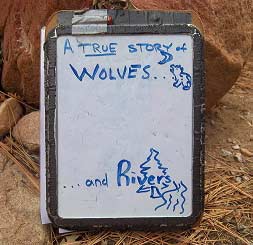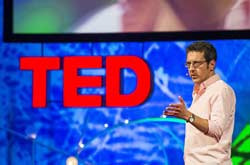“Let me tell you a story of wolves and rivers,” I tell my students, “…Gray wolves of Yellowstone were one of the earliest species in North America to be considered endangered in 1967. Gray wolves had been hunted down to near extinction until they became protected. Then environmental agencies and organizations tried ‘reintroducing’ only 21 protected gray wolves back into their old territory in Yellowstone National Park in 1995. As of 2012, 83 gray wolves now survive in the park”.
I continue. “I want you to think about what could happen to an environment when 21 wolves are reintroduced. I also want you to consider other things researchers have observed since 1995: the rivers have changed courses, bears have increased in numbers, trees have gotten taller. I told you this would be a story of wolves and rivers – how are all these connected?”

George Monbiot’s TED talk begins with his discovery of “rewilding” and the wolves of Yellowstone National Park. Wolves, he supports, have a lot of characteristics similar to humans – family behavior, growth of knowledge, etc. That is in part one of the reasons canines have become domesticated by humans, because of the characteristics each have in common. But the complexities of this species are not the meat of Monbiot’s talk; rather it is his focus on the radical experiment of re-introducing wolves into their old habitats that grabs the listener’s attention.
 Talking about the re-introduction of wolves to Yellowstone National Park in 1995, Monbiot does not delve into detail about numbers and politics, but he describes in broad strokes the situation and its effects. Prior to 1995 (within the near 30 years of gray wolf endangerment and protection) the deer and elk population, no longer having natural predators, had been continuously high and because of that the over-grazing of local vegetation was a constant concern for naturalists and park officials.
Talking about the re-introduction of wolves to Yellowstone National Park in 1995, Monbiot does not delve into detail about numbers and politics, but he describes in broad strokes the situation and its effects. Prior to 1995 (within the near 30 years of gray wolf endangerment and protection) the deer and elk population, no longer having natural predators, had been continuously high and because of that the over-grazing of local vegetation was a constant concern for naturalists and park officials.
 As soon as the wolves were reintroduced, they hunted some of the deer and elk, but more dramatically the deer began to specifically avoid locations and space where the wolves lived and hunted. Those spaces began to regenerate with trees growing taller and birds moving in, growing shrubs provided more berries for an increasing bear population, beaver populations rose with more trees to graze on and their new dams re-routed rivers. These new river routes became habitats for otters and ducks. The wolves, although small in number not only changed the biological makeup of the park, but also the geography of the park.
As soon as the wolves were reintroduced, they hunted some of the deer and elk, but more dramatically the deer began to specifically avoid locations and space where the wolves lived and hunted. Those spaces began to regenerate with trees growing taller and birds moving in, growing shrubs provided more berries for an increasing bear population, beaver populations rose with more trees to graze on and their new dams re-routed rivers. These new river routes became habitats for otters and ducks. The wolves, although small in number not only changed the biological makeup of the park, but also the geography of the park.
How I use this in my classes
Monbiot describes the above example of ecosystem change within Yellowstone National Park, and this is the part I use most with students at High Trails. This works well in Team Discovery, but I can also tell it with classes like Plant Detectives, Furry Friends or Environmental Awareness.
 I begin by telling my students that I want to tell them a true story about “Wolves & Rivers” and proceed to tell them two apparently separate events: the reintroduction of wolves in 1995 and the changing of the course of rivers a few years in the future, sprinkling in the facts about bears or songbirds or otters or beavers or trees.
I begin by telling my students that I want to tell them a true story about “Wolves & Rivers” and proceed to tell them two apparently separate events: the reintroduction of wolves in 1995 and the changing of the course of rivers a few years in the future, sprinkling in the facts about bears or songbirds or otters or beavers or trees.
I have them hypothesize if, why, and how these events could possibly be connected. By the end of the lesson, I reveal what Monbiot discovered: a small wolf population actually caused rivers to change direction and that one small group can affect all the other parts of an ecosystem.
“But here’s where it gets really interesting. The wolves changed the behavior of the rivers. They began to meander less. There was less erosion. The channels narrowed. More pools formed, more riffle sections, all of which were great for wildlife habitats. The rivers changed in response to the wolves, and the reason was that the regenerating forests stabilized the banks so that they collapsed less often, so that the rivers became more fixed in their course. Similarly, by driving the deer out of some places and the vegetation recovering on the valley sides, there was less soil erosion, because the vegetation stabilized that as well. So the wolves, small in number, transformed not just the ecosystem of the Yellowstone National Park, this huge area of land, but also its physical geography“. – George Mondiot, in his TED Talk.
 Monbiot continues in his TED talk to describe other ecosystems, including ocean ecosystems and the effect whale “fecal plumes” have on the ocean plankton and the interconnectedness of plants and animals on Earth. He describes how whales actually do not lower plankton population but in fact sustain them. It is another example of how narrow human vision can be towards ecosystems: the narrow-mindedness in this case that hunting whales should increase plankton populations.
Monbiot continues in his TED talk to describe other ecosystems, including ocean ecosystems and the effect whale “fecal plumes” have on the ocean plankton and the interconnectedness of plants and animals on Earth. He describes how whales actually do not lower plankton population but in fact sustain them. It is another example of how narrow human vision can be towards ecosystems: the narrow-mindedness in this case that hunting whales should increase plankton populations.
 Monbiot closes by advocating “rewilding” of areas, not conserving past ecosystems but rather protecting and re-introducing species into areas where they have been removed.
Monbiot closes by advocating “rewilding” of areas, not conserving past ecosystems but rather protecting and re-introducing species into areas where they have been removed.
This final part of Monbiot’s talk I use the least. He readily admits this idea of his is the hardest to pitch to people – taking land and making more of it into national parks where we protect and introduce species, and that lions and elephants should be brought back to foreclosed farms in Britain. He encourages nations to take more risks with not just protecting land, but seeing the effects of “rewilding” land beyond the Yellowstone National Park example.
In Closing
This TED Talk is particularly accessible to students and Monbiot’s report on wolves and rivers provides a very clear and entertaining example of the need for space, the balance of populations, and the interconnectedness of ecosystems. When we discuss something like FWARPS with students, certain ideas readily make sense to 5th and 6th graders: food, water, air, and protection in particular. But ‘S’ – Space – can use an example like Monbiot’s revelation of the impact of wolves and clearly demonstrate SPACE for students. Wolves did not kill all the deer; they just took the space they needed. Taking that space kept them alive, kept the deer alive, kept the trees and shrubs alive, kept the beavers alive and much more ecological diversity alive in the park.
Taking the story that Monbiot presents, making it a real world puzzle for students to solve, and then revealing the entire true story, I have found to be accessible, engaging, and memorable for students.
At High Trails Outdoor Science School, we literally force our instructors to write about elementary outdoor education, teaching outside, learning outside, our dirty classroom (the forest…gosh), environmental science, outdoor science, and all other tree hugging student and kid loving things that keep us engaged, passionate, driven, loving our job, digging our life, and spreading the word to anyone whose attention we can hold for long enough to actually make it through reading this entire sentence. Whew…. www.dirtyclassroom.com

Comments are closed.